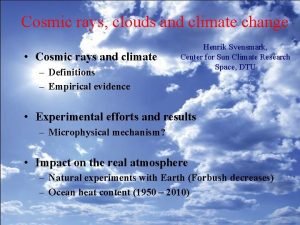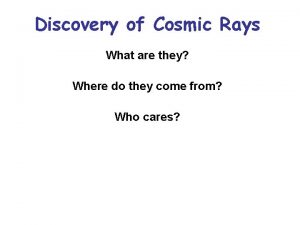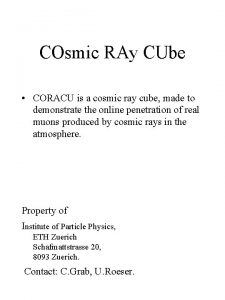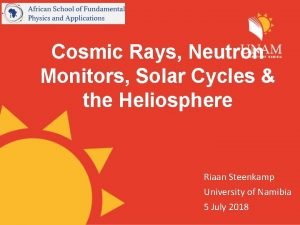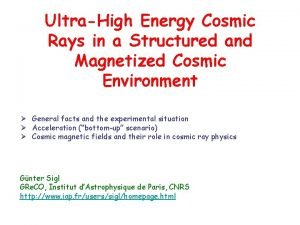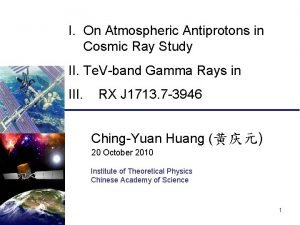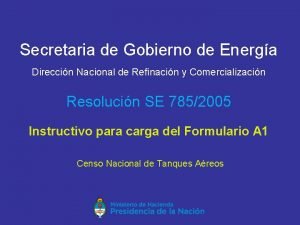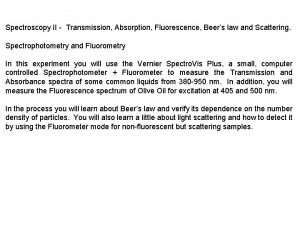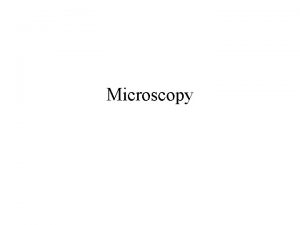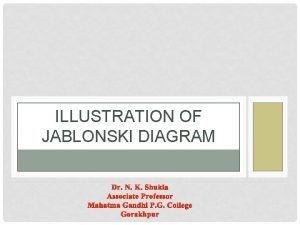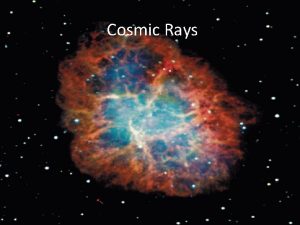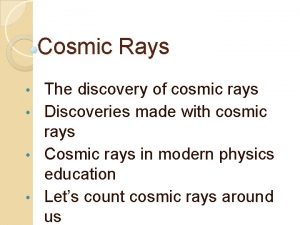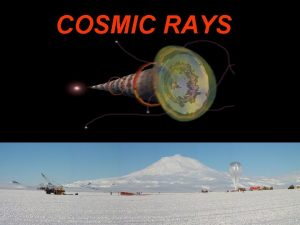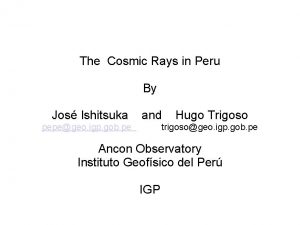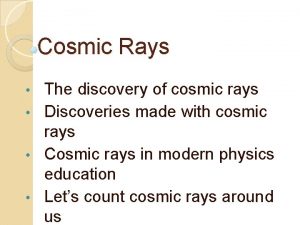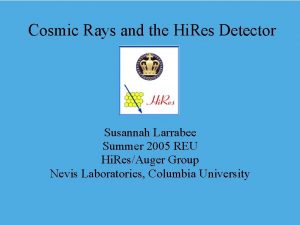Cosmic Rays in Fluorescence Hi Res and TA












- Slides: 12

Cosmic Rays in Fluorescence Hi. Res and TA P. Sokolsky High Energy Astrophysics Institute University of Utah Salt Lake City, Utah 9/16/2020

Status of Hi. Res n n 9/16/2020 Two stations, 12. 5 km apart Hi. Res I - 22 mirrors, 256 tubes/mir. S/H electronics - completed in ‘ 98. Monocular data taking in progress - two years of data in hand. Hi. Res II - 42 mirrors, FADC electronics completed in July 1999. Stereo data taking began in May 1999. Data taking projected for five year run.

Capabilities of Hi. Res Experiment n n n 9/16/2020 Stereo instantaneous aperture grows to 10, 000 km 2 -str at 1020 e. V. Factor of ten over Fly’s Eye Energy resolution 10% Xmax resolution 30 gm/cm 2 Angular resolution better than. 4 deg Measure Spectrum, Composition, and Anisotropy. Search for Neutrino flux

Some Results: Hi. Res/CASA/MIA n n n 9/16/2020 Study of cosmic ray composition near 1017 e. V using Xmax and muon multiplicity methods. First simultaneous measurement of shower longitudinal profile development and muon content. Xmax method: measure distribution of shower Xmax and compare to Monte Carlo predictions for pure proton and pure Fe flux.

Some Results: Hi. Res/ CASA/MIA continued n n n 9/16/2020 Monte Carlo uses Corsika shower simulation and detailed Hi. Res and MIA detector simulation. Use qgsjet and Sybil hadronic models implemented in Corsika. Compare Xmax and (600) elongation rates with predictions Data is consistent with a transition from a heavy to a light composition - in agreement with previous Fly’s Eye results. Data prefers qgsjet model.

Some Results: Preliminary Monocular Hi. Res I data n n 9/16/2020 Hi. Res I monocular data from 1. 5 years analyzed using constrained Xmax method. Monte Carlo studies indicates method works well above 1019 e. V. Energy resolution tails require additional study. Spectrum slope and normalization consistent with F. E. monocular results. Analysis of data continuing. Validation of method with Stereo data in process.

Beyond Hi. Res: What the Fluorescence Method Can Contribute n n 9/16/2020 n Origin and propagation models make specific predictions about cosmic ray composition above GZK cutoff - in particular many predict large gamma ray and neutrino fluxes. Xmax method has been shown to work at lower energies - can resolve heavy vs light composition Measurement of longitudinal shower development yields unique signature for gamma rays above GZK cutoff Good angular resolution increases sensitivity to point sources of neutral particles. Robust determination of neutrino candidates

Gamma Ray Signatures - LPM effect and magnetic brem. n n n 9/16/2020 Above 1019 e. V, gamma ray showers become more penetrating and wider due to LPM effect. Above 1020 e. V, gamma ray showers can pair-produce on the Earth’s geomagnetic field. This generates a distribution of secondary gamma rays at the top of the troposphere. Result is a superposition of em showers with Xmax very near classical Bethe-Heitler predictions. Which effect dominates depends on arrival direction of gamma ray with respect to Earth’s magnetic coordinate system. Fluorescence detector will measure correct energy for both cases. Xmax as function of energy and Nmax/E as function of energy will distinguish gamma rays from hadrons.

Neutrino Signatures n n 9/16/2020 Detector is sensitive to CC electron neutrino interactions. Neutrino candidates identified by penetration typically showers deeper than 2000 gm/cm 2 of atmosphere. Near horizontal events require very good angular resolution to control depth errors. Average angular resolution of better than. 4 degrees is possible. Upward going event rate boosted by LPM effect in Earth’s crust.

Telescope Array Proposal n n n n 9/16/2020 Collaboration between Japan, US and Australia Propose to build 10 Hi. Res-like sites extending from present Hi. Res sites to proposed Northern Auger site in Utah. Instantaneous aperture at 1020 e. V is 80, 000 km 2 str. About a factor of ten increase over Hi. Res. Statistical reach in five year run is 1021 e. V. Provides excellent energy, angular and Xmax resolution. Strength is particle identification. Effective neutrino volume at 1020 e. V is 1. 2 x 1010 ton str for events deeper than 2000 gm/cm 2 Can operate to complement Northern Auger ground array.

Telescope Array Status n n n n n 9/16/2020 Japan/US/Australia collaboration formed - 1998 Japanese proposal to Monbushu submitted -1999 Japanese funding expected - 2001 US proposal to NSF/DOE expected in 2000 Project completion estimated in 2005 Utah site survey and BLM permission ongoing Design of buildings, infrastructure and communications Choice of mirror size Design and testing of electronics

How it All Fits Together n n n 9/16/2020 Hi. Res - verify and extend AGASA flux measurement - reach 3 x 1020 e. V. Southern Auger - high statistics ground array experiment - reach 1021 e. V. Northern Auger - repeat but with Northern hemisphere sources. Telescope Array - high statistics fluorescence detector - reach 1021 e. V and good particle id. OWL/AIRWATCH - ultimate cosmic ray detector statistical reach to beyond 3 x 1021 e. V.
